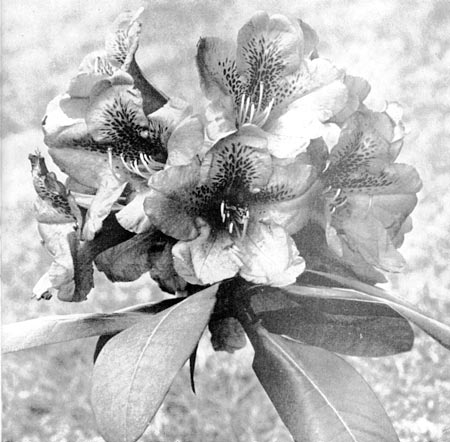QBARS - v11n4 Two Rhododendron Hybrids of Note
Two Rhododendron Hybrids of Note
By P. H. Brydon
Rhododendron 'Susan' ( campanulatum x fortunei ?) A.M. 1930, A.M. 1948, F.C.C. 1951. The list of awards received by this hybrid indicates that it has gained in popularity over the past twenty years. It's steady rise as a desirable garden plant in British gardens has a parallel in the U.S., for each year the demand seems to increase, and with good reason.
R. 'Susan' is not the easiest hybrid to increase vegetatively and the young cuttings look awkward at first with their open and stiff growth. However, once the plant has settled down and put on a few year's growth, it becomes a shapely bush with wonderfully healthy rounded deep green leaves which remain on the plant for several years and give it a solid dense quality which is so desirable in the garden.
Its parentage is somewhat obscure, although it is undoubtedly closely related to R. campanulatum, as a matter of fact it maybe a form of this species. Some authorities believe it to be a hybrid between campanulatum and fortunei , but I fail to recognize the fortunei influence in the hybrid. In any event, all are agreed that it was discovered by Mr. P. D. William and is referred to as "Williams campanulatum hybrid" in the excellent book on Hardy Rhododendrons by Mr. Frederick Street.
As can be seen by the illustration (Fig. 31) the truss is rounded and nicely filled. The inside of the upper petals is spotted and marked purple and the color of the flower might best be described as lavender blue with a shading of mauve. This is one of the best large flowered "blue" rhododendrons and we have found it to be hardy to 10 below zero. The flowers appear in early May and the plant will make a compact sturdy bush about 4 feet high in ten years.

|

|
|
Figure 34. R. 'Susan'
Brydon photo |
Fig. 35. R. 'Queen of Hearts' A. M.
Brydon photo |
Rhododendron 'Queen of Hearts' ( meddianum x Moser's Maroon) A.M. 1949 (Fig. 35).
When the late Lionel de Rothschild made this cross, it is evident that he had in mind a mid-season red rhododendron which would combine the rich crimson of the seed parent R. meddianum with the robust constitution of R. 'Moser's Maroon'. The latter is an old hybrid which Mr. de Rothschild used to produce such outstanding varieties as 'Grenadier' and 'Romany Chal', both of which appear to be less hardy than 'Queen of Hearts'. It is interesting to note that the bright red young growth of 'Moser's Maroon' is not evident in any of its progeny. R. meddianum the Chinese form of R. thomsonii which it resembles very closely except that the former is more compact in growth and has deeper colored flowers. Its influence is apparent in the rounded leaves of the hybrid and there is a decided improvement in the dull color of Moser's Maroon.
Mr. Peter Barber of Exbury was kind enough to provide the illustration of 'Queen of Hearts'. However, the truss is by no means typical since plants which have bloomed in the Willamette Valley produced nicely filled dome shaped trusses of 16 deep crimson blossoms, each flower marked and spotted with black on the upper petals. It blooms in late April and is a welcome addition to the deep reds, particularly since it has proven hardy to 5 degrees above zero. It is possible that it could withstand lower temperatures because 5 above has been the lowest we have experienced since acquiring this variety. The growth habit is rounded and the rich green leaves are thick in texture, elliptic lanceolate in shape, about 4¼ inches long and 2½ inches wide. An estimate of the plant's height in ten years would be about 5 feet.
